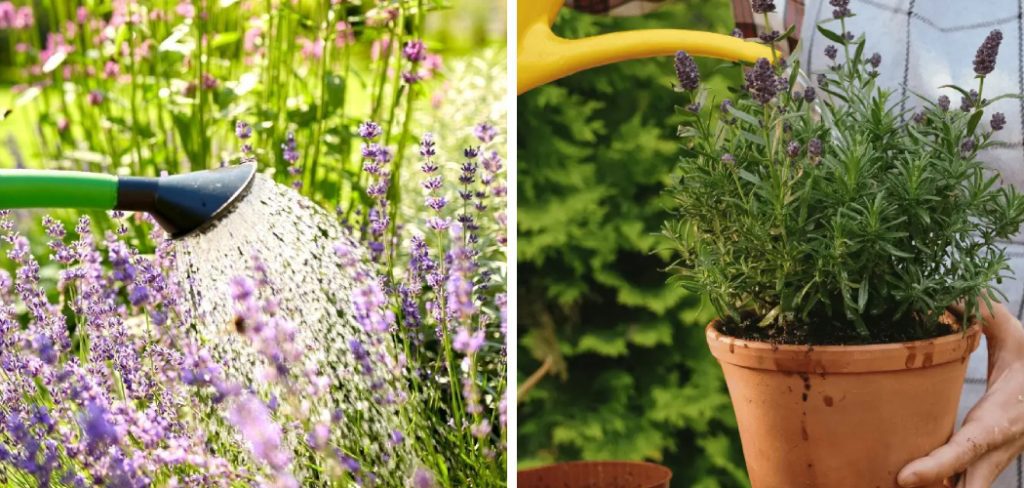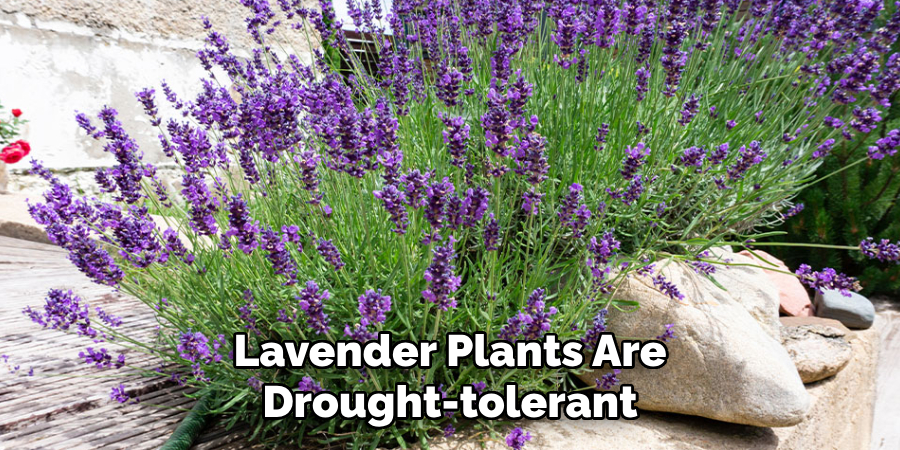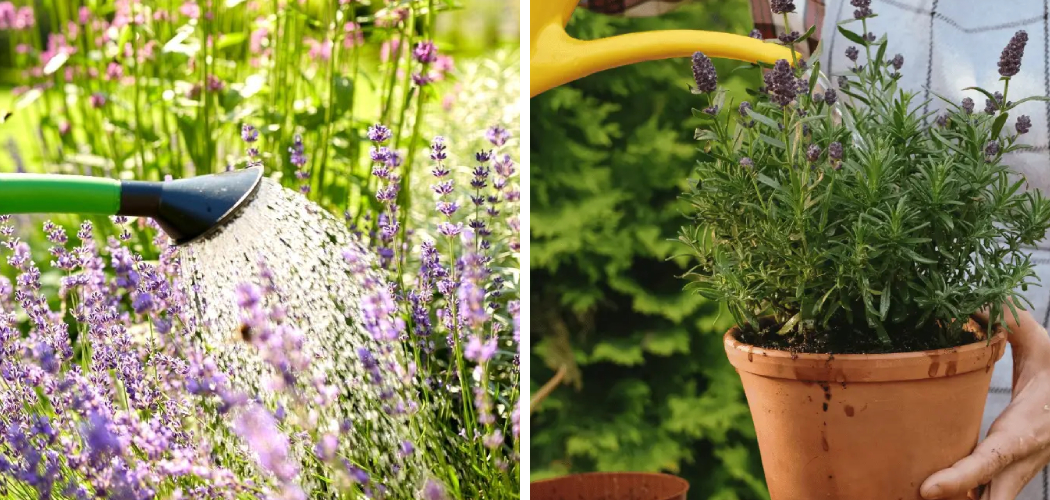To water lavender plants, ensure you provide deep watering once a week, avoiding overwatering to prevent root rot. Lavender plants thrive best in well-draining soil and should be watered at the base of the plant.
Lavender plants, scientifically known as lavandula, are popular for their aromatic fragrance and beautiful purple flowers. These plants require proper watering to ensure their health and growth. We will discuss the most effective way to water lavender plants. By adhering to a few simple guidelines, you can help your lavender plants thrive and enjoy their lovely blooms throughout the season.
Learn how to provide the right amount of water for your lavender plants and keep them healthy and vibrant.

How to Water Lavender Plants: Step by Step Guide
Understanding Lavender’s Watering Needs
Understanding how to properly water lavender plants is essential for their growth and health. Lavender has specific watering needs that must be taken into consideration. The importance of providing the right amount of water cannot be overstated. Factors such as the type of soil, climate, and season play a key role in determining how often and how much water lavender plants require.
It is crucial to avoid overwatering, as this can lead to root rot and other problems. On the other hand, underwatering can cause the plants to wither and die. To effectively water lavender, it is recommended to follow certain guidelines.
These guidelines include checking the soil moisture, watering deeply but infrequently, providing proper drainage, and avoiding wetting the foliage to prevent diseases. By following these tips, you can ensure that your lavender plants thrive and flourish.
Tips For Watering Lavender Plants
Watering lavender plants requires careful consideration of the frequency, timing, and soil moisture levels. To determine the right watering schedule for your lavender, observe the plant’s growth and the weather conditions. Lavender plants thrive in well-draining soil, so be mindful not to overwater.
It is best to water the plants in the early morning or late evening when the temperatures are cooler, reducing evaporation. Regularly monitor the soil moisture levels by checking the top few inches of the soil. If the soil feels dry, it’s time to water.
However, make sure not to let the lavender sit in soggy soil, as this can lead to root rot. By following these tips, you can ensure that your lavender plants receive the optimal amount of water to thrive.
Techniques For Watering Lavender Plants
Watering lavender plants correctly is crucial for their health and growth. One effective technique is to water the plants at the base, near the roots. This ensures that the water reaches the plant’s roots directly. Another important tip is to avoid overhead irrigation.
Lavender plants do not like to be watered from above, as it can lead to excess moisture and dampness, which can promote disease and rot. Instead, opt for drip irrigation systems. These systems allow for slow and targeted watering, providing the plants with the right amount of moisture without overwatering.
By following these techniques, you can ensure that your lavender plants thrive and flourish, enhancing the beauty of your garden.
Assessing Lavender Watering Requirements
Lavender plants require proper watering to thrive. Underwatering signs include wilting and drooping leaves. Overwatering signs include yellowing leaves and root rot. Monitoring the soil moisture is crucial to ensure the right amount of water is provided. It is recommended to wait for the top inch of soil to dry before watering again.
Lavender plants prefer deep watering rather than frequent light watering. Adding a layer of organic mulch around the plant can help retain moisture and prevent water evaporation. It is important to water the plant at its base, avoiding wetting the leaves.
Adjusting the watering frequency according to weather conditions and plant growth is key. By following these guidelines, you can efficiently water your lavender plants and promote their overall health.
Additional Factors Affecting Lavender Watering
Lavender plants’ watering needs are influenced by additional factors such as soil type and drainage. The type of soil and its ability to drain water directly impact the amount of water needed. Similarly, climate conditions and temperature also play a key role in lavender watering.
Understanding the specific climate of your region helps determine the appropriate watering schedule. Moreover, the difference between container and in-ground plants must be considered. Container plants require more frequent watering compared to in-ground plants, as their roots have limited access to water.
Take these factors into account when watering lavender plants for optimal growth and health.
Preparing Lavender For Optimal Watering
When watering lavender plants, it is important to consider proper site selection and soil preparation. Choose a location that receives full sunlight for at least six hours a day. This ensures optimal growth and flowering. The soil should be well-draining, as lavender plants don’t thrive in wet conditions.

To improve drainage, amend heavy or clay-like soil with organic matter such as compost or sand. This helps create a looser texture that allows excess water to flow through. Avoid overwatering lavender plants, as they are drought-tolerant and prefer slightly dry conditions.
Water deeply but infrequently, allowing the soil to dry out between waterings. By following these guidelines, you can provide your lavender plants with the proper care and ensure their health and vitality.
Addressing Common Watering Issues
Lavender plants require proper watering techniques to thrive. One common watering issue is dealing with soggy or waterlogged soil, which can cause root rot and hinder growth. To address this problem, ensure that the soil has good drainage by adding organic matter or perlite.
Avoid heavy clay soil or overwatering. On the other hand, if the soil is dry and parched, you should water the lavender plants deeply and infrequently. This encourages deep root growth and prevents shallow roots that are susceptible to drought.
Watering in the early morning or late afternoon is ideal to reduce evaporation. Remember to water at the base of the plants, avoiding the foliage. With these watering tips, your lavender plants can flourish in well-drained soil and bloom beautifully.
Frequently Asked Questions For How To Water Lavender Plants
How Often Should Lavender Plants Be Watered?
Lavender plants should be watered once every two weeks, making sure the soil is moist but not waterlogged. It’s important to let the soil dry out slightly between waterings to avoid root rot.
Can Lavender Plants Survive With Little Water?

Lavender plants are drought-tolerant and can survive with little water. Once established, they only need occasional watering, usually during periods of prolonged drought. Overwatering can harm the plant, so it’s best to let the soil dry out between waterings.
Should Lavender Plants Be Watered From Above Or Below?
Lavender plants should be watered from below at the base of the plant to avoid wetting the leaves. This helps prevent fungal diseases and keeps the plant healthy. Watering from above can lead to moisture buildup on the leaves, promoting disease.
Can Lavender Plants Tolerate Rainwater?
Lavender plants can tolerate rainwater, but it’s important to ensure proper drainage to prevent waterlogging. If the soil becomes waterlogged after heavy rainfall, consider using raised beds or adding organic matter to improve drainage.
Should Lavender Plants Be Watered In The Morning Or Evening?
It’s best to water lavender plants in the morning, allowing time for the foliage to dry before evening. Watering in the evening can lead to prolonged moisture on the leaves, increasing the risk of fungal diseases. Morning watering helps ensure optimal plant health.
Conclusion
To sum it up, watering lavender plants requires a delicate balance of providing enough moisture without drowning the roots. It is important to water the plants deeply and infrequently, allowing the soil to dry between waterings. Overwatering can lead to root rot and ultimately the death of the plant.
Additionally, lavender plants prefer well-draining soil and benefit from the use of mulch to retain moisture. Remember to water the base of the plant and avoid getting the foliage wet to prevent diseases. Monitoring the weather conditions and adjusting watering frequency accordingly will ensure the health and vitality of your lavender plants.
By following these guidelines, your lavender plants will thrive and reward you with their beautiful flowers and soothing fragrance. Keep your lavender plants well-watered, but not too much, and watch them flourish. Happy gardening!

